Report: GloCoBank Conference on Cross-Border Payments in Historical Perspective (27-28 March 2025)
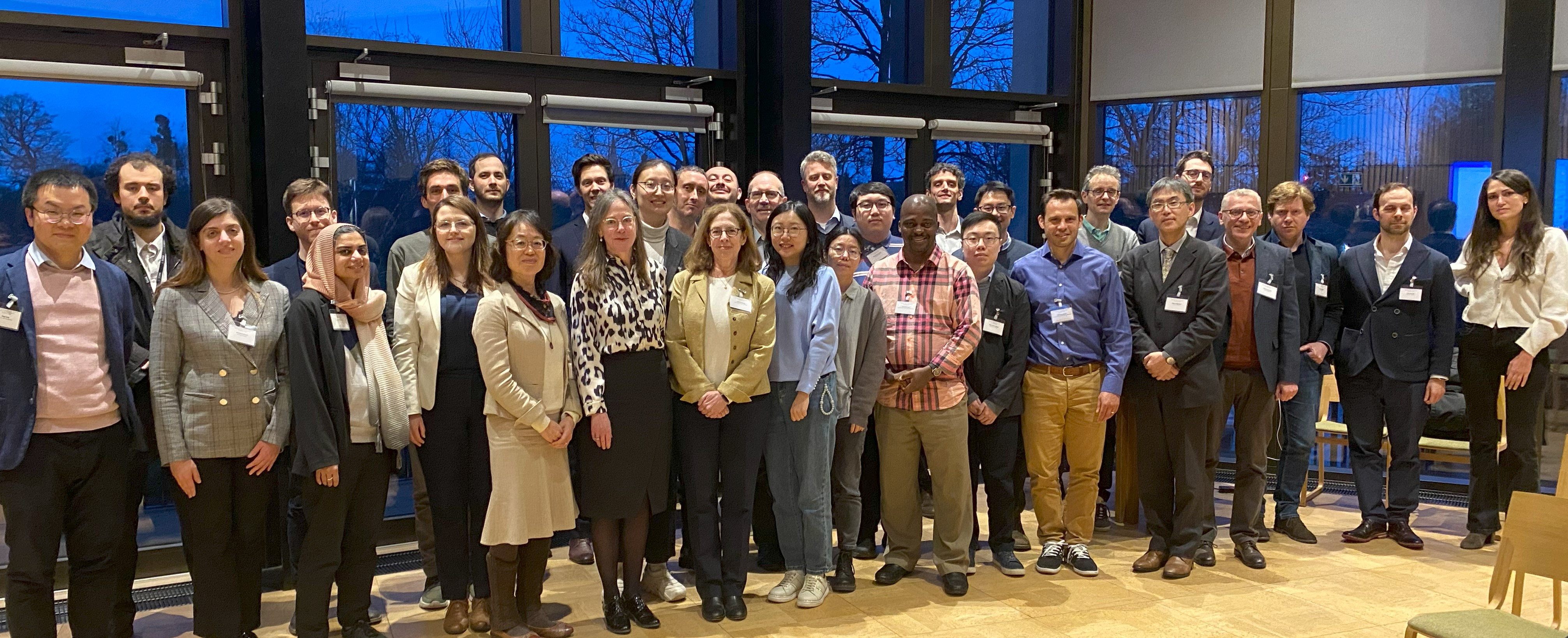
GloCoBank conference participants

Catherine Schenk (Opening Lecture)
The end of March was a busy time for the ERC-funded GloCoBank project, led by Principal Investigator, Professor Catherine Schenk, as the project hosted an international conference on the history and evolution of cross-border payment systems from Thursday 27th to Friday 28th March 2025, preceded by an early career scholars workshop on the 26th March (read workshop report here). The workshop and conference sought to bring together researchers working on cross-border payments systems in a range of historical contexts to further stimulate debate. Set in the light-filled Riverside Pavilion at St Hilda’s College, overlooking the river Cherwell and Oxford’s spires, the Project welcomed 37 participants to three days of stimulating discussion and community building.
The two-day conference started with an opening lecture by Professor Schenk in which she provided an overview of the cross-border payments system, explaining its significance and what GloCoBank aims to accomplish through the new dataset on correspondent banking relations from 1920 to 1985.
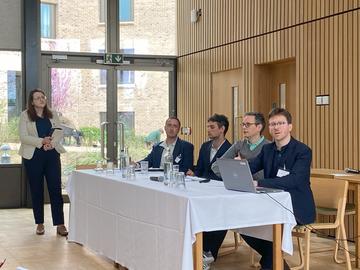
R-l: Adrien Faudot, Arnaud Mehl, Marco Molteni, Jamieson Myles, Sabine Schenk
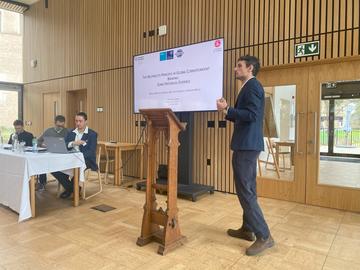
Marco Molteni
The first panel featured three presentations on the structures and framework of cross-border payments from a historical perspective. Adrien Faudot (University of Grenoble Alpes) discussed his research on the Deutsche Verrechnungskasse, the German clearing institute, during World War II. The presentation examined the monetary integration process in 1940, the evolving role of the DVK as a clearing centre for all countries trading with Germany, its operational mechanics, and the issues of asymmetry and adjustment between countries that emerged within this payments system. The presentation demonstrated that the evolution of the DVK's practices was driven by the dynamics of rationalisation, political and economic integration, and exploitation, and that the institutional setup depended on eliminating correspondent banking and the absence of foreign exchange markets, which were supplanted by a central clearinghouse managing central bank accounts.
Marco Molteni (University of Turin) and Jamieson Myles (University of Geneva) discussed the principle of reciprocity in global correspondent banking and banks’ internationalisation strategies. Using archival evidence from European banks (Banca Commerciale Italiana, Banque de l' Union Parisienne, Banco Santander) and from the Americas (Banco Nacional de México, Banco de México), the presenters underscored the relational (compared to transactional) aspect of correspondent banking. The presentation demonstrated how the persistence of bilateral relationships between banks depended on cooperation to enhance business and mutual benefits through the reciprocity of service and business exchanges. A point was also made regarding the tensions between the reciprocity principle and the effective balance of business among banks.
Arnaud Mehl (European Central Bank) presented his co-authored paper with Massimo Ferrari Minesso, Olga Triay Bagur, and Isabel Vansteenkiste on geopolitics and the global interlinking of fast payment systems. Using a newly constructed dataset on fast payment links from 2016 to 2023, he analysed the role of economic, technical, and geopolitical factors in the interlinking of payment systems across 117 countries. The presentation highlighted the strength of geopolitical effects, as the findings suggest that the reduction in the probability of payment links between geopolitically distant countries is more substantial than that for geographically distant ones.
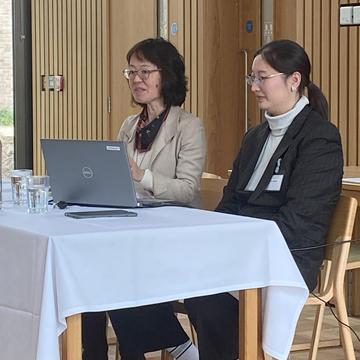
L-r: Mariko Hatase, Nora Yitong Qiu
The second panel included presentations on American and Asian payments. Mariko Hatase (Hitotsubashi University), Nora Yitong Qiu (UCL), and Catherine Schenk (University of Oxford/GloCoBank Project) analysed the origins, structure, strategy, and transformations of Japanese correspondent banking and payment networks in the twentieth century within a global context. They stressed the government's important role in defining the network's shape and scale. They concluded by referring to the interesting, yet still unanswered, question regarding the role of correspondent banking and branching within the broader internationalisation strategies of Japanese banks.
Next, Simon Mollan (University of York), Ayumu Sugawara (Tohoku University), and Mark Billings (University of Exeter) presented their work on the financing of Japanese industry in the 1960s and the Eurocurrency markets. They presented their newly constructed dataset covering all commercial loans and trade finance facilities to Japanese banks and industrial firms between 1964 and 1971. Through this, they showed how Japanese banks accessed the London Eurodollar market, providing finance to Japanese industry in the 1960s, with a particular focus on short-term loans and trade finance for industrial exports to Latin America.
Marianna Astore (University of Insubria) presented the final paper in the session, placing remittances in the context of correspondent banking and global payment systems. With Italian remittances playing a significant role in supporting families and local economies, Marianna discussed the case of Banco di Napoli during the first global economy between the 1870s and the First World War in fostering Italian migrant remittances from the U.S. and Argentina. The presentation analysed the economic and institutional factors behind the Bank's focus on remittances and the mechanisms it employed to reduce transaction costs, manage currency exchange risks, and build trust between migrants and their families. By reconstructing Banco di Napoli's international network and taking a comparative approach, the presentation highlighted the role of correspondent banking in facilitating migrant remittances.

L-r: Ayumu Suguwara, Mark Billings, Simon Mollan
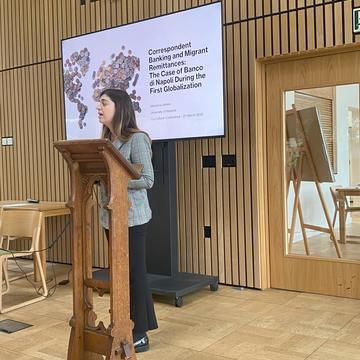
Marianna Astore
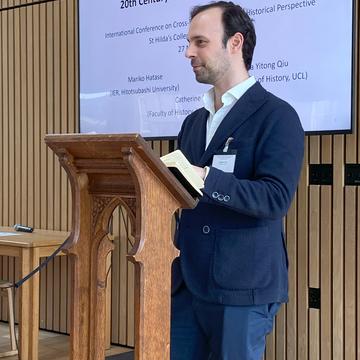
Giovanni Pala (Chair)

R-l: Sebastian Alvarez, Marco Molteni
The last panel of day one was dedicated to European payments. First, Sebastian Alvarez (Universidad Adolfo Ibáñez/Graduate Institute Geneva) and Marco Molteni (University of Turin) presented their paper on the Eurobond market and the rise of global payment infrastructure between 1963 and 1974. They placed the development of the Eurobond market within the broader context of the evolution of cross-border payment systems. They demonstrated how the emergence of the Eurobond market was instrumental in the development of International Central Securities Depositories. They examined the positive consequences of the regulatory and institutional environment of the 1960s and early 1970s, particularly U. S. capital controls and European tax measures, in creating institutional arrangements for new, market-driven payment and clearing systems that remain integral to today's global financial architecture. They also illustrated how these arrangements survived the crisis of the early 1970s despite high price elasticities. They emphasised that the lessons learnt from the development of the Eurobond market remain relevant today for navigating the challenges of an increasingly integrated global payments system.
Next, Alexis Drach (University Paris 8) explored various interconnected themes such as the rise of credit cards, cross-border payment systems at the regional level, European integration in the 1970s and 1980s, and the creation of the European Council for Payment Systems in 1978. Focusing on retail payment systems, Alexis noted the reaction of European banks to the competition from American players such as Visa and from non-banks from the late 1970s to the early 1990s, highlighting how political, economic, and technical questions were closely intertwined.

Alexis Drach

Sabine Schneider
Finally, GloCoBank's Sabine Schneider discussed the internationalisation strategies of German universal banks between the 1960s and 1980s. She argued that the key driver for the growth in the international business of German universal banks from the late 1970s was overseas branching and multinational expansion. This had an impact on the substantial core business of correspondent banking. The presentation also touched upon how the increasing information gathering for country risk assessment in the late 1970 s and 1980 s exerted pressure on the profitability of cross-border payments, particularly as personnel costs rose with transaction volumes before the advent of SWIFT. She illustrated how the focus of German banks shifted towards expanding interbank connections beyond international financial centres to include specialist regionally active banks in Latin America, Asia, and COMECON.
In the evening, conference speakers and the GloCoBank research team convened for a conference dinner to discuss their research in the context of plans for a conference publication.
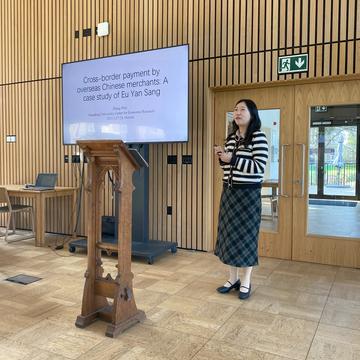
Wen Zhang
Day two started with a panel session centred around trade and payments. First, Wen Zhang (Shandong University) presented her research on the cross-border payments by overseas Chinese merchants from the late imperial period to the early twentieth century. The presentation focused on Eu Yan Sang, a Chinese merchant. She highlighted the role of Chinese merchant networks in facilitating cross-border trade before the widespread adoption of modern banking systems. The presentation demonstrated how Eu Yan Sang acted as a ‘cross-border remittance’ institution. Utilising remittance certificates, fund transfers, and inter-branch settlements indicates that Eu Yan Sang played an important role as a financial intermediary in the Chinese community in Southeast Asia, helping Chinese immigrants transfer funds internationally. The presentation concluded by highlighting that Eu Yan Sang had a dual function, serving as a bank and a commercial activity.
Next, Wilfried Kisling (WU University Vienna) discussed the heterogeneous trade effect of the classical gold standard, focusing on Argentina's import data from 1875 to 1913. He showed how the gold standard, while facilitating international trade through stabilising exchange rates, had a different impact across countries, products, and tariff regimes. Wilfried also explored the surging trade flows that were associated with bilateral adherence to the gold standard. Yet, the presentation noted a strong trade effect when trading partners had higher import shares and with products in capital- intensive industries.

Wilfried Kisling
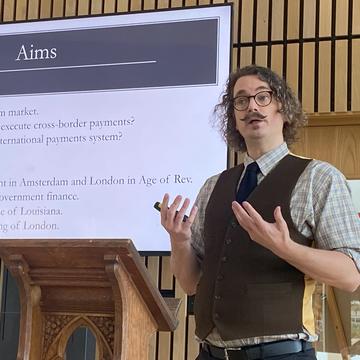
Mark Hay
The final presentation in this panel was delivered by Mark Hay (Erasmus University Rotterdam) on cross- border payments in 1803-1804 for financing the Louisiana Cession. He posed the interesting question of whether international finance became anglicised or if London internationalised by adopting Dutch practices. The presentation discussed the migration of the global payment system from Amsterdam to London through the prism of the largest financial operation of the early nineteenth century- the financial operation to facilitate the transfer of political authority over Louisiana territory from France to the United States. The paper presented compared Dutch and British approaches to global payments in the late eighteenth and early nineteenth centuries. Mark argued that Dutch credit networks were more resilient than often believed, and that, while the centre of the global payments system did migrate to London, this was partly because British houses adopted Dutch practices for international payments.
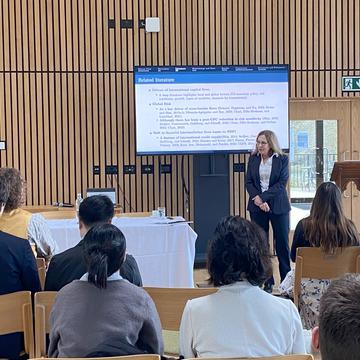

Linda Goldberg (Keynote Speaker)
The keynote lecture was delivered by Linda Goldberg (Federal Reserve Bank of New York), who presented her work on the risk sensitivity of global liquidity flows. She urged that participants on both the borrower and supply sides of financing must be unpacked to better understand global liquidity dynamics. The tightness of financiers’ balance sheet constraints determines how sensitive borrowers are to risk shocks. Additionally, the composition of financiers matters for risk sensitivities.
The conference was a fantastic opportunity to develop scholarship in this area, with many important connections made and ideas for collaboration developed. The Project is grateful to all participants for their contributions and looks forward to following up regarding a conference publication.
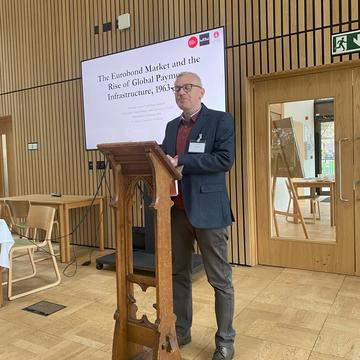
Akram Beniamin (Chair)
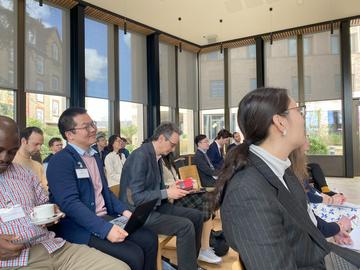
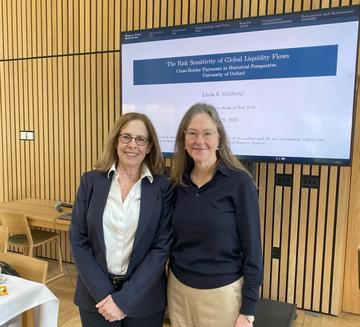
Linda Goldberg, Catherine Schenk
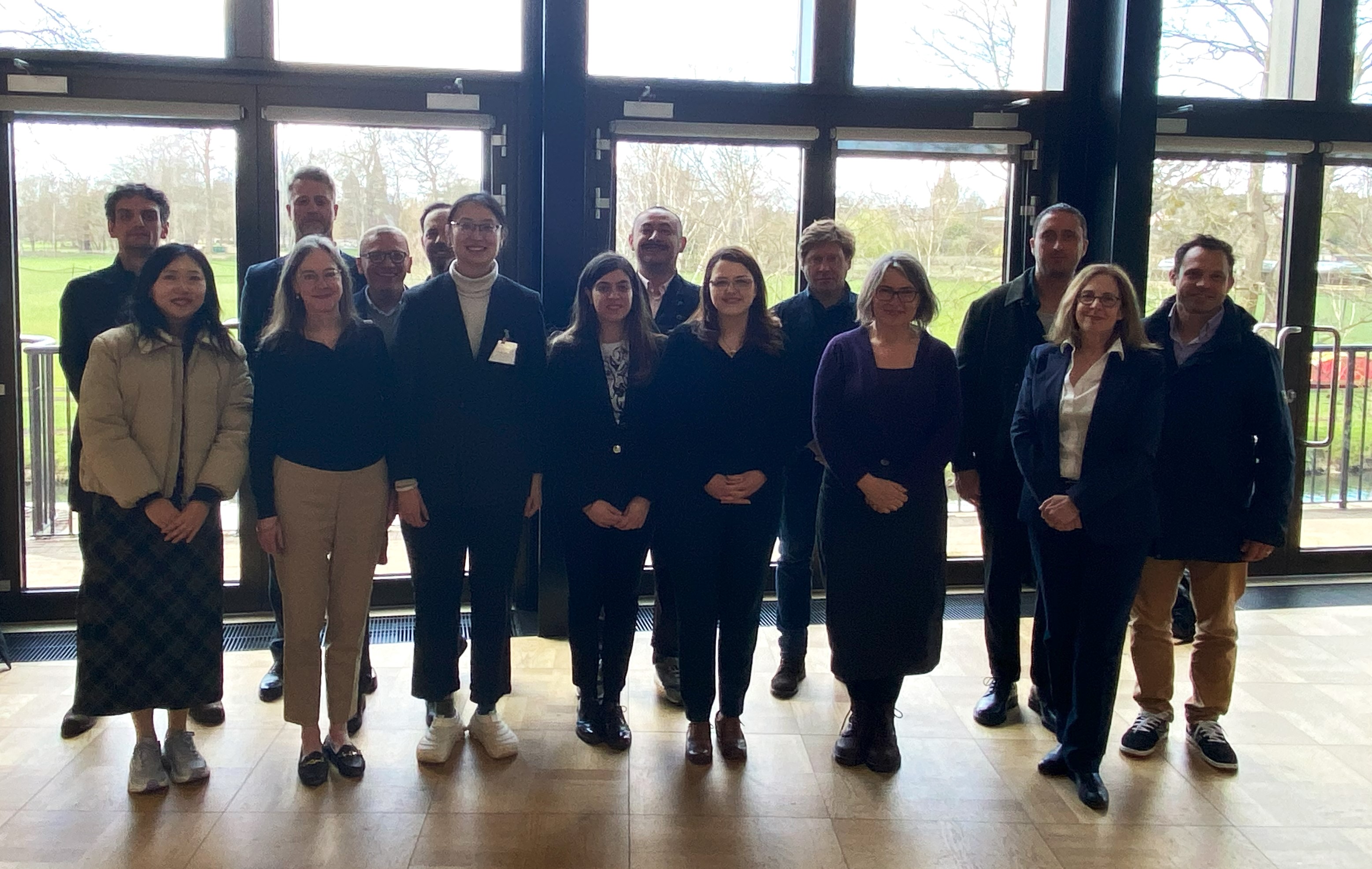
GloCoBank research team & associates (r-l): Alvarez, Goldberg, Myles, Phillips, Mollan, Schneider, Bautista-Gonzalez, Astore, Qiu, Pala, Beniamin, Schenk, Kisling, Zhang, Molteni
Report authors: Giovanni Pala, Akram Beniamin, Claire Phillips



